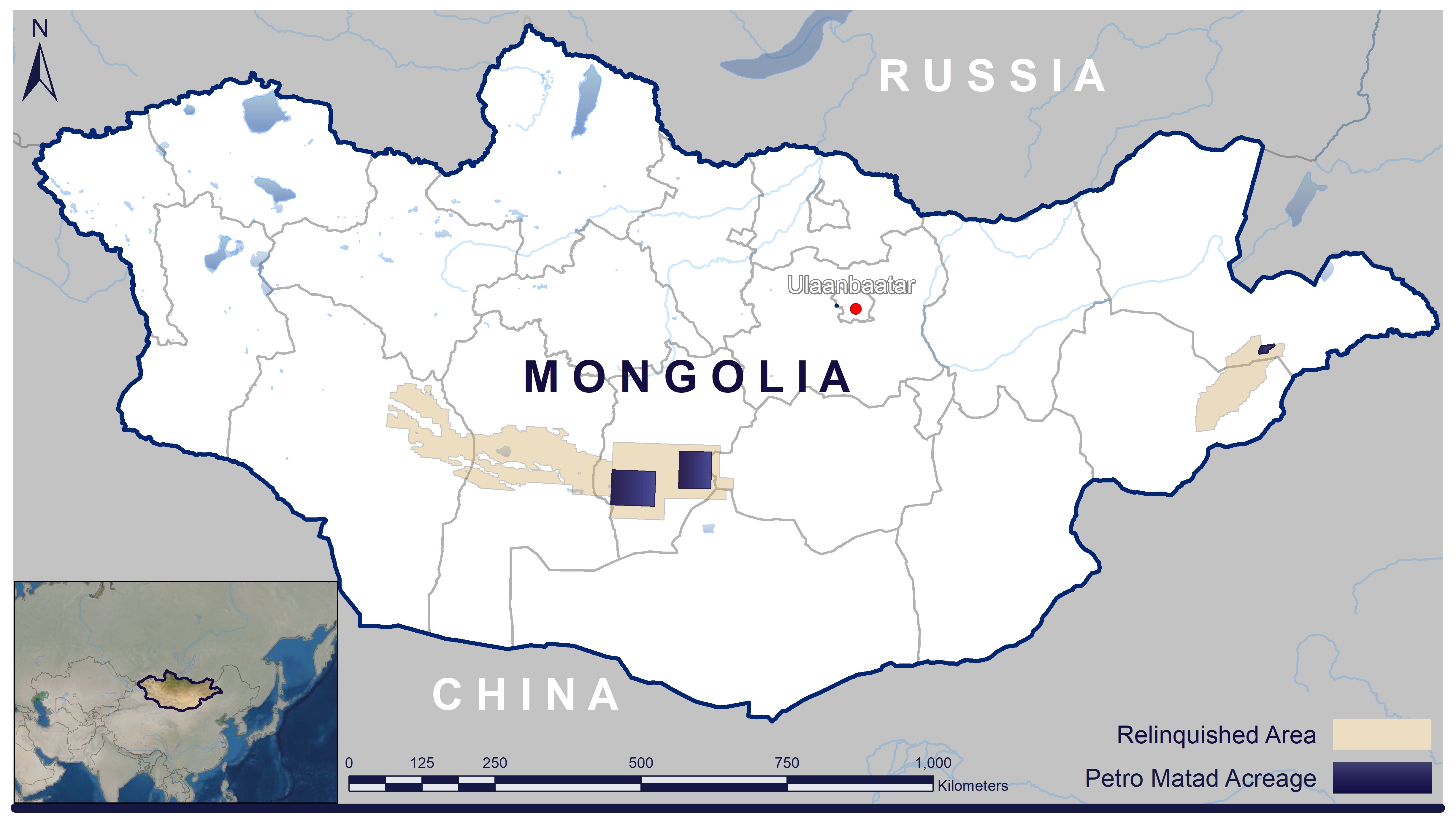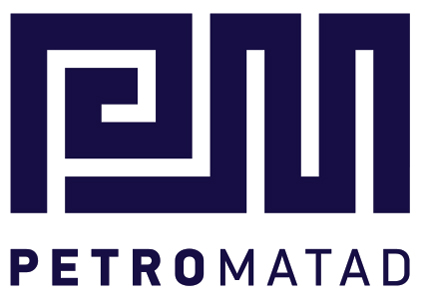- Holds 100% interest in 2 PSC Blocks (V and XX) totaling more than 8,151km2
- Focussed on developing the Heron-1 Discovery in Block XX and maturing future drilling prospects around Heron and in Block V
- Drilled two wildcat exploration wells, Red Deer-1 and Gazelle-1, and one appraisal well, Heron-1, in 2019 in Block XX
- Successfully well tested Heron-1 and formally declared it a discovery
- Gazelle-1 suspended with good oil shows for potential future well testing
- Red Deer-1 P&A’d with oil shows. First well in the Asgat Basin in southern Block XX and proved presence of an active petroleum system
- Exploitation License over Heron discovery awarded in July 2021 covering an area of 214km2 with the remaining acreage relinquished
- Heron-1 first oil planned in 2022
- Partial relinquishment of Block V retaining both the Taats Basin where Snow Leopard-1 wildcat exploration well was drilled with oil shows, and Tugrug Basin where petroleum systems have been proven
- Following post-well studies on Wild Horse-1 wildcat exploration well in 2018, Block IV fully relinquished in August 2020
- Block V put into moratorium in 2020 due to Covid-19 pandemic related issues. Moratorium expired end 2022 with the end of final exploration period extended to 28 July 2024
- Drilled Velociraptor Prospect in July 2023 with the well plugged and abandoned as a dry hole although good quality reservoir sandstones were encountered
- Post well studies ongoing to determine remaining prospectivity in Block V and the Valley of the Lakes basins
- Participating in the MRPAM Tender Round for new exploration acreage launched end 2022. Petro Matad submitted several applications for new blocks to refresh the portfolio and negotiations and block awards are expected to be concluded before the end of 2023

Assets Overview

Petro Matad has been one of the most active exploration companies in Mongolia since 2005. The company holds a prominent position in the frontier and emerging hydrocarbon basins of Mongolia. The company has two Production Sharing Contracts, Blocks V and XX, covering a total area of 8,151 km2 . The company initially established a foothold in the country through its active exploration campaign in Block XX where the development of the Heron-1 discovery is actively being pursued following the award of the Exploitation Licence in July 2021 .
Blocks IV and V
Blocks IV and V, located in the frontier area of western Mongolia saw the first wildcat exploration wells drilled during Petro Matad’s 2018 drilling campaign resulting in two petroleum systems being identified. Detailed analysis of the well results and integration with seismic data re-mapping high-graded the Taats and Tugrug Basins in Block V for potential future drilling and these areas have been retained with the rest of the licence area relinquished. Interpretation of the results of the Wild Horse-1 well in Block IV concluded that there was insufficient potential across the entirety of the block and it has subsequently been fully relinquished by the end of 2020. The opportunity remains to re-licence smaller tranches of acreage where prospectivity has high-graded.
The initial exploration work commenced on Bogd Block IV and Ongi Block V in 2009 with the acquisition of regional gravity data and acquisition of reconnaissance seismic lines across the potential basins identified by the gravity data. These blocks had never previously been seriously explored for oil and gas; consequently, there was no subsurface information of any description. The early exploration work identified potential basins; and exposed outcrops at the basin margins provided the easiest way to collect data on potential reservoir and source rocks. Exploration field work resulted in the discovery of world-class oil shale deposits, which demonstrated the existence of potentially rich source rocks across the blocks.
Blocks IV and V database consists of 4,400 kms of 2D seismic, 200 km2 of 3D seismic, 11,000 km2 of airborne acquired FTG and HRAM, the first acquired in the region; continuous core recovered from drilling of two deep stratigraphic holes (3000m total; 1400m and 1600m each); data obtained from extensive field work campaigns; and analysis of samples collected from various sites in the blocks.
Within the Baatsagaan Basin of Block IV the Wild Horse-1 well was spudded on 23 October 2018 reaching a Total Depth of 1490m MD in Basement granites somewhat shallow than prognosed. Following the evaluation of wireline logs, the well was plugged and abandoned with gas shows on 29 November 2018 with no Lost Time Accidents reported during the 38 day operation. Post-wells studies led to downgrading of the prospectivty of the Baatsagaan Basin.
Within the Taats Basin of Block V the Snow Leopard-1 well was spudded on 9 July 2018 reaching a Total Depth of 2830m MD in Basement granites. Following the evaluation of wireline logs the well was plugged and abandoned with oil and gas shows on 25 September 2018 with no Lost Time Accidents reported during the 80 day operation. Although commercial volumes of hydrocarbons were not encountered, post-well analysis has proven the occurrence of a migrated oil in the well and a thick unit of rich source rocks which together prove the presence of an active petroleum system in Taats Basin. This information led to upgrading the Raptor Trend of prospects located along the southern margin of the basin with the Velociraptor Prospect chosen for drilling. The Velociraptor-1 well was spudded on June 11th 2023 and drilled to a depth of 1500 m and following analysis of geological samples and wireline logs the well was plugged and abandoned with the rig released on July 15th. During the 33 day operation no Lost Time Accident. Three thick, good quality reservoir sandstone intervals were encountered in the well but indications of oil show were absent. Post well studies ongoing to determine remaining prospectivity in Block V and the Valley of the Lakes basins.
Block XX
Block XX is adjacent to the main oil producing region of Mongolia, the Toson-Uul Graben of the Tamsag Basin in Block XIX, operated by PetroChina. The main proven and producing petroleum system is the Upper Jurassic-Lower Cretaceous play. The Heron-1 well proved the extension of commercial volumes of oil into Block XX and following approval of a Reserves Report and Plan of Development a 214km2 Exploitation Licence was awarded in July 2021 which covers the full extent of the Heron discovery, the area up-dip of the Gazelle-1 discovery and undrilled exploration targets having significant upside. First oil and additional development well drilling is targeted for 2022. Following the award of the Exploitation Licence, which has an initial 25 year term, the rest of exploration acreage has been relinquished.
In July 2023, the Mongolian Cabinet approved Block XX Exploitation area to be certified as special purpose area which allows for the final agreements to be established with local governments to fully legalise access to the acreage for first oil operations to proceed.
Petro Matad’s initial exploration campaign in Block XX consisted of re-processing existing seismic data and acquisition of 2D and 3D seismic surveys and drilling eleven wells (2010/11) on the Davsan Tolgoi structural high with hydrocarbon shows being encountered however no commercial discovery was made.
Re-processing of 2D seismic data and access to the overlap of PetroChina’s acquired 3D seismic data into the northern part of the block significantly reduced the uncertainty on possible extensions of discovered oil into Block XX and matured potentially commercial drilling prospects which become the focus of Petro Matad’s 2019 drilling campaign.
To the southwest, prospective but frontier basins had been identified on coarse 2D seismic and gravity data on trend and with a similar stratigraphic and structural style to the proven systems in adjacent Erlian Basin of China. Of particular interest was the furthest south basin, the Asgat Sag, where the Red Deer Prospect was matured for drilling during the 2019 drilling campaign.
At the southern end of the prolific Toson-Uul Basin and targeting an extension of a PetroChina oil discovery in Block XIX, Heron-1 well was spudded on 19 July 2019 reaching a Total Depth of 2960m MD within the Lower Tsagaantsav Formation and below last observed oil shows. Well data and analysis of wireline logs identified 70m of oil shows within which three zones across a 40m interval were clear candidates for well testing. Testing operations across two of the three zones were completed on 31 October 2019 with commercial rates achieved prompting the application of an Exploitation Licence across the northern part of the block for the development of this discovery and definition of possible upside potential.
A few kilometres west, the Gazelle-1 wildcat exploration well was spudded on 18 September 2019 on a separate structure but immediately updip of another PetroChina oil accumulation. Total depth of 2550m MD and reached in sediments of the Sharilyn Formation and good oil shows were observed at the top of the targeted Lower Tsagaantsav Formation. Wireline logs identified the presence of two oil bearing zones and the well was suspended on 18 October 2019 for potential future testing.
Within the Asgat Basin in southern Block XX, Red Deer-1 wildcat exploration well reached a Total Depth of 2000m MD on 14 September 2019 having encountered oil shows across much of the objective Zuunbayan and Tsagaantsav Fm targets. Log analysis however did not identify any intervals for testing and the well was plugged and abandoned and the rig released on 20 September 2019. Geochemical analysis of the oil show samples indicates the presence of a mature and active petroleum system in this basin too. The Asgat and surrounding basins are now available for relicensing and consideration is being given to this.
